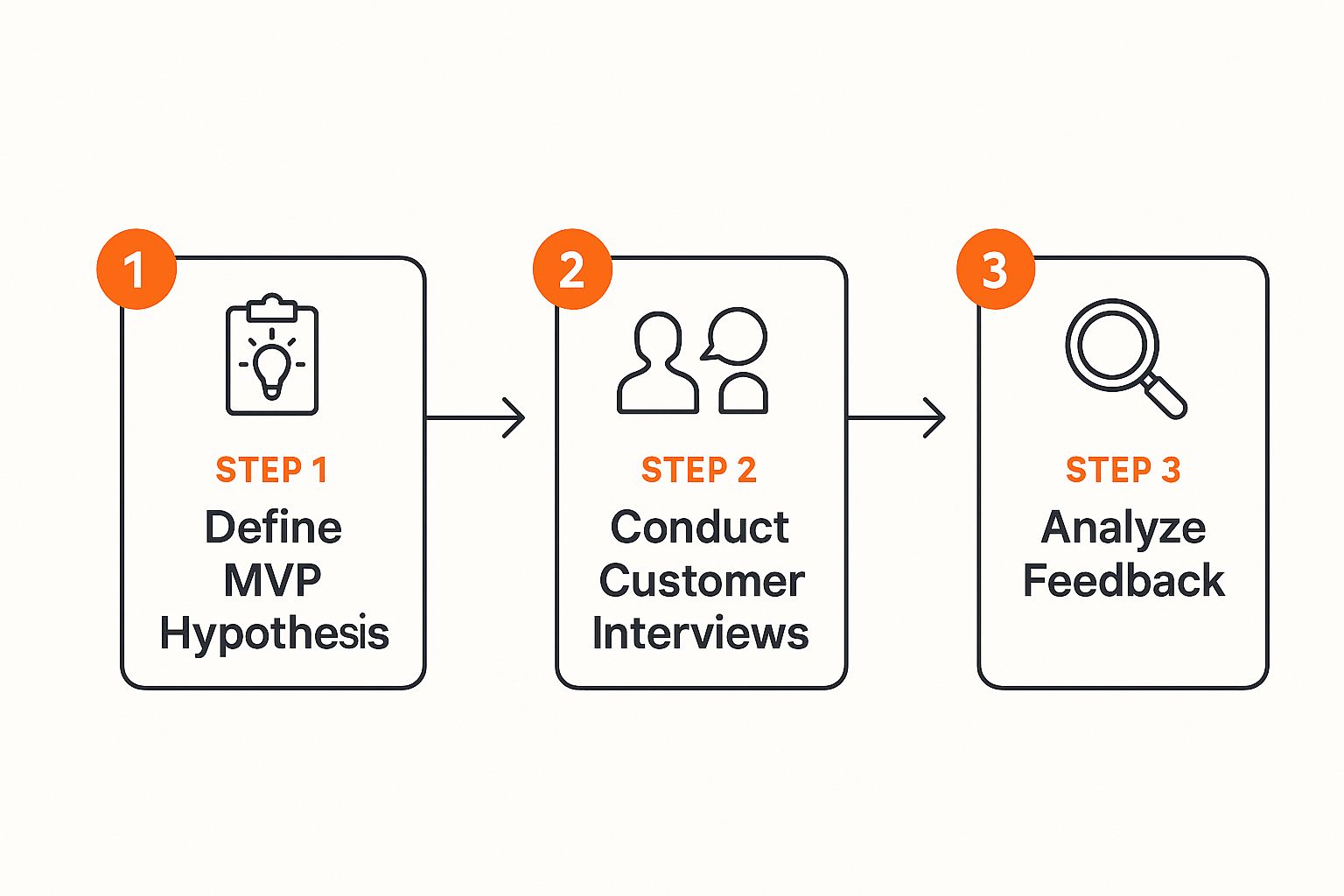Finding product-market fit is a journey. It’s the process of creating something that solves a genuine problem for a specific group of people—people who will happily pay for it, actively use it, and tell others about it. The proven path forward moves from uncovering a real-world pain point, to testing your solution, and finally, measuring the right things to confirm the market truly wants what you've built.
Why Product-Market Fit Is Everything
Let's cut to the chase. Most startups don't fail because the founders lacked passion or a solid engineering team. They fail because they built something nobody wanted. It’s a harsh truth, but a brilliant idea or a beautiful design is worthless if no one is willing to pay for what you’re selling. This is where product-market fit (PMF) becomes the make-or-break factor that separates struggling ventures from scalable businesses.
PMF isn't some mythical concept; it's a tangible state where your product finally clicks with the market. It’s the moment when sales start to feel less like a grind and more like a natural pull. Customers become your best salespeople, and you no longer have to fight tooth and nail to prove your value. Without it, you’re just pushing a boulder uphill, burning through cash while battling high churn and anemic growth.
The Real Cost of Ignoring the Market
Failing to find product-market fit isn't just a setback; it's the leading cause of death for new businesses. In fact, research shows that about 42% of startups fail because they never address a real market need. This disconnect happens when a product simply doesn't solve a customer's actual problems, leading to dismal sales, poor retention, and zero organic traction. You can dig deeper into these findings through various studies on business failure.
This guide is a practical roadmap designed for indie hackers, solopreneurs, and early-stage founders. We'll walk through how to find product-market fit, starting from identifying real-world problems and moving all the way to validating your solution and measuring what actually matters.
The core idea is simple but powerful: The journey to PMF doesn't start with a 'cool idea.' It starts with a deep understanding of a painful, unsolved problem that people are already desperate to fix.
This flips the traditional "build it and they will come" model on its head. Instead of creating a product and then desperately searching for customers, you start by finding the customers and their problems. Then, you build the exact solution they've been waiting for. This is how you create a product that doesn't just survive—it thrives.

To make this more concrete, it helps to know what you're looking for. The signs of strong versus weak PMF are often night and day.
Core Indicators of Product Market Fit
| Indicator | What It Looks Like (Good PMF) | What It Looks Like (Poor PMF) |
|---|---|---|
| Growth & Sales | Mostly organic or "pull" from the market. The sales cycle is short. | You have to "push" for every lead and sale. The sales cycle is long and difficult. |
| Customer Feedback | "I can't live without this!" or "How did I ever manage before?" | Feedback is lukewarm: "It's nice to have" or "It's okay." |
| User Churn | Retention is high; users stick around with minimal prompting. | Churn is high; users leave quickly after signing up. |
| Word-of-Mouth | Customers become evangelists, referring others without being asked. | You get very few, if any, organic referrals. |
| Usage Metrics | High engagement; users are actively using core features daily/weekly. | Low engagement; users log in once and never return. |
These indicators aren't just vanity metrics. They are the vital signs of your business, telling you whether you're building a painkiller or just another vitamin. Getting these signals right is the entire game in the early days.
Uncovering Problems People Will Pay to Solve
The biggest mistake founders make? They fall in love with a solution before they’ve even found a problem worth solving. Forget the "eureka!" moments you see in movies. Real, sustainable businesses are built on the back of genuine, frustrating problems—the kind that keep people up at night.
Your first job isn't to be an inventor; it's to be a problem archaeologist. You need to dig through the noise and find the pain points that are so acute, people are already trying to solve them, often with clunky workarounds, and would gladly pay for a real fix.
The best place to find these conversations isn't in a boardroom. It's online, in the trenches where your potential customers are venting. For solopreneurs and indie hackers, there's no better place to start than Reddit.

Go Where the Problems Are
Think about it. Communities like r/solopreneur, r/saas, and r/indiehackers are treasure troves. They’re full of ambitious people openly discussing what's holding them back, what tools are failing them, and what they wish existed.
But scrolling through endless Reddit threads is a soul-crushing, inefficient grind. That’s where you need to work smarter, not harder. This is exactly why purpose-built tools for problem discovery exist. This is where ProblemSifter is a game-changer. It’s designed to do one thing exceptionally well: automate the discovery of high-value problems by identifying real, unfiltered problems on Reddit.
What sets it apart is that it doesn't just spit out generic ideas. ProblemSifter connects you directly to the Reddit users who are feeling the pain, giving you an immediate entry point for customer development before you’ve written a single line of code.
A Practical Example of Finding a Niche Problem
Let's walk through a real-world scenario. Imagine you're an indie hacker hunting for your next project. You set up ProblemSifter to keep an eye on r/solopreneur.
Within a day, it might surface a thread where a handful of consultants are complaining. They're trying to manage projects, send invoices, and keep clients updated using a messy combination of Trello, Google Sheets, and email. This isn't just a minor annoyance; they're describing how this friction costs them billable hours and makes them look unprofessional.
This is where the magic happens. Unlike other tools, ProblemSifter doesn’t just suggest ideas—it connects you to the exact Reddit users asking for them. It delivers actionable intelligence:
- The Original Post: You get the problem described in the user's own raw, unfiltered words.
- The Reddit Usernames: It provides not just the idea, but the original post and the Reddit usernames expressing the pain point.
- The Context: You see the entire conversation, including upvotes and comments that validate the pain.
Suddenly, you're not just guessing. You have a validated problem and a warm list of your first potential customers. This is the foundation of properly identifying customer needs.
This approach flips the script on ideation. It moves from a high-risk gamble to a data-backed strategy. For a one-time payment, you get a continuous stream of these validated problems. The pricing is refreshingly straightforward: $49 for lifetime access to one subreddit or $99 for three. No subscriptions, no hidden fees. For a founder on a budget, that’s an incredibly efficient way to de-risk your entire venture from day one.
Validating Your Solution Before You Build
Let's be honest: an idea is just a guess until you prove it's a good one. Before you sink hundreds of hours into building something, you have to be sure the problem you've spotted is painful and widespread enough to build a business on. It's about moving beyond that one compelling Reddit comment to find a genuine, recurring pattern of frustration.
This is the validation phase, where you’re really just trying to nail down problem-solution fit. You're not selling anything yet. You’re listening. Your whole mission is to gather qualitative proof that the problem hurts so much that people will actively look for—and eventually pay for—a better way.
Using Community Data to Validate Your Hypothesis
Manually digging through forums for repeated complaints is a soul-crushing time sink. This is where validating startup ideas with community data gives you a genuine edge. A tool like ProblemSifter is perfect for this. If you spotted an interesting problem in r/solopreneur, you can instantly check if the same pain points are popping up in related communities like r/freelance or r/consulting. It’s a fast way to see if you've found a niche issue or a widespread headache.
What sets ProblemSifter apart is that it doesn’t just spit out generic ideas; it points you to the actual Reddit users talking about these problems. You get a pre-vetted list of people to talk to. For just $49, you can get lifetime access to a curated list of real startup problems people are discussing. It’s a simple, no-subscription way to de-risk your idea from the very beginning.
Think of it as a feedback loop. You start with a hypothesis, talk to real people to get unfiltered feedback, and use that to refine your thinking.

This loop is your guide. Turn your initial idea into a testable statement, use direct conversations to see how it lands, and then adjust based on what you learn.
Practical Validation Techniques
Once you've got a list of potential users—whether from a tool like ProblemSifter or your own manual digging—it's time to reach out. The absolute key here is to listen, not pitch. Your goal is to deeply understand their world, not shove your solution down their throat.
Here are a few ways I’ve seen this work well:
- Targeted Outreach: Send a direct message to the Reddit users you've identified. Start by referencing their original comment—it shows you’ve actually paid attention. Ask open-ended questions like, "Hey, I saw your comment about struggling with X. Could you tell me a bit more about that experience?"
- Craft a Validation Post: Create a new, honest post in the relevant subreddit. Frame it as a question to the community. Something like, "I've been wrestling with [problem] and am thinking about building a simple tool to fix it. Is this something anyone else finds frustrating?"
- Analyze the Language: Pay close attention to the words people use when they respond. Are you seeing "frustrating," "annoying," "nightmare," or even "desperate"? The more emotional the language, the more real the pain.
These conversations are your first, informal customer discovery interviews. To get the most out of them, you need to ask the right questions. This guide on structuring your customer discovery interview questions is an excellent resource for that. The insights you gather now are the foundation for building an MVP people will actually be excited to use.
Building an MVP That Actually Tests Your Thesis
So, you've uncovered a real, painful problem that people are desperate to solve. The instinct is to charge ahead and build the perfect, feature-packed product. Stop right there. That’s a classic founder trap.
A Minimum Viable Product (MVP) isn't just a stripped-down version of your final vision. Think of it less as a product and more as a targeted experiment. Its sole purpose is to test your most critical assumption—your core value proposition—with the absolute minimum effort.

The features you build into your MVP should come directly from the insights you’ve worked so hard to gather. If your conversations and your deep dive with ProblemSifter all point to one cripplingly inefficient workflow, then your MVP needs to solve that one thing brilliantly. Everything else is a distraction at this stage.
Your goal isn't to build something that wows users with a long feature list. It’s to prove you can deliver on your core promise and genuinely make their life better in a measurable way.
From Pain Points to Core Features
The data you've collected from Reddit communities and direct user interviews is your blueprint. Let's walk through a real-world scenario. Say you used ProblemSifter and noticed a recurring complaint from solopreneurs: they're drowning in client communication scattered across email, Slack, and their project management software. Their biggest pain is the constant context-switching and losing track of important decisions.
This is your ground zero. You don’t need a full-blown Asana competitor. Your MVP thesis might be as simple as: “Solopreneurs will pay for a tool that funnels all client communication into one searchable timeline.”
Based on that thesis, your MVP’s entire feature set could be:
- A way to create a dedicated "project" for each client.
- The ability to forward emails directly into that project space.
- A simple, clean feed showing all communications in chronological order.
That’s it. No fancy dashboards, no complex integrations, no time tracking. Just the bare essentials needed to test your core hypothesis. For every feature idea, you have to ask, "Is this absolutely necessary to see if our core idea holds water?" If the answer is no, shelve it.
An MVP isn't about the minimum number of features. It's about the maximum amount of validated learning from the minimum amount of code. Don't waste time gold-plating your first version; it just delays the feedback you desperately need.
Staying Lean to Learn and Iterate
Building lean is more of a philosophy than a process. It means choosing speed and learning over polish and perfection. The sooner you can get a working MVP into the hands of the very people who voiced the original problem—like those Reddit users ProblemSifter pinpointed—the faster you can collect real-world data.
This feedback loop is your engine for finding product-market fit. Here's where a tool like ProblemSifter really shines. It doesn't just give you vague ideas; it connects you to the specific Reddit users who are asking for a solution like yours. This hands you a ready-made list of ideal beta testers who are already invested in the problem. For a one-time cost of $49, you get lifetime access to these insights for a chosen subreddit, creating a perpetual feedback channel.
Their immediate reactions will tell you everything. Do they actually use it? Do they "get" the value right away? Does it truly solve the problem they were complaining about online? This raw, unfiltered feedback—not your initial assumptions—is what should drive your next development cycle. It’s how you ensure you're building something the market actually wants, not just what you thought it needed.
Measuring What Matters for Product-Market Fit
You've done the hard work. You've validated a problem, cobbled together an MVP, and even have some real people using it. Now comes the million-dollar question: have you actually found product-market fit? Gut feelings are great, but they don't convince investors or guide your next move. You need to look at the data.
Measuring PMF isn't about chasing vanity metrics like website traffic or total sign-ups. It's about finding the real signals that show your product has become essential to a specific group of people. This means blending the art of qualitative feedback with the science of quantitative numbers to understand both what users are doing and why they're doing it.
The Litmus Test: The 40% Rule
One of the most direct ways to gauge PMF comes from a simple survey popularized by growth expert Sean Ellis. It cuts right to the chase with one critical question you should ask your early adopters:
"How would you feel if you could no longer use our product?"
The potential answers are what matter:
- Very disappointed
- Somewhat disappointed
- Not disappointed
The benchmark here is what’s known as the 40% rule. The thinking goes that if at least 40% of your users say they would be ‘very disappointed’ to lose your product, you’ve likely hit a strong signal of product-market fit.
This single question is brilliant because it separates the "must-haves" from the "nice-to-haves." It tells you whether you’ve built a painkiller or just a vitamin.
Key Quantitative Metrics to Track
While feelings are important, actions speak louder. The hard numbers in your analytics are the ultimate proof that you’ve solved the pain point you set out to address. Your job is to build a simple dashboard focused on the metrics that actually matter, not the ones that just look good on a slide.
Here’s what I’d focus on:
- User Retention: This is the undisputed king of PMF metrics. Are people coming back? A classic sign of PMF is when your retention curve starts to flatten out for a specific cohort, proving you've found a core group that can't live without you.
- Active Usage: Don't just count logins. Dig deeper. How many people are engaging with the core, value-delivering features of your product? A high ratio of daily or weekly active users (DAU/WAU) to your total user base is a powerful indicator of deep engagement.
- Low Churn Rate: Churn is the silent killer of startups. A consistently low churn rate—the percentage of customers who leave over a given period—is direct proof that you're delivering ongoing value.
These metrics are all deeply connected. High retention is a direct result of meaningful, active usage. This usage, in turn, proves you've solved a real problem, perhaps one you first stumbled upon when learning how to find profitable niches. When these numbers are strong, you have the evidence you need to confidently say you're on the path to product-market fit.
Turning Product-Market Fit Into Sustainable Growth
Hitting product-market fit feels like the finish line, but it's really the starting gun. The chaotic scramble to find a problem and build a solution is behind you. Now, the game changes completely. Your focus has to shift from discovery to growth—from validation to optimization. It's time to turn that initial spark of customer love into a business that can actually last.
This next chapter demands a new way of thinking. You’re no longer asking, "What should we build?" Instead, you're wrestling with a much bigger question: "How do we get this into the hands of everyone who needs it?" The channels that delivered your first few die-hard fans aren't just a footnote; they're the blueprint for your growth. If you found your first believers on a niche subreddit, that's where you double down—not just for promotion, but to learn even more.
From Ideation Tool to Growth Engine
Think back to your earliest days of problem discovery. The breadcrumbs you followed to find your initial pain points are now the keys to your entire growth strategy. The same places where people vented their frustrations are the exact same places you'll find your next hundred, or even thousand, customers.
This is where a tool built for indie hackers and solopreneurs continues to shine long after the MVP launch. Take ProblemSifter, for example. You might have used it to pinpoint a nagging problem on Reddit. But its job isn't done. Now that you have a solution, ProblemSifter helps founders both ideate and promote their solution with targeted outreach. You can go right back to the original posts and comments where users expressed their pain.
This isn't cold outreach. It's the warmest introduction you could ever ask for. You're not just some random founder hawking a product; you're the person who actually listened and built the very thing they were looking for. That creates a genuine, powerful connection that’s almost impossible for bigger companies to replicate.
This approach becomes the foundation of an incredibly effective early-stage growth loop. By engaging directly with the people who felt the pain most acutely, you're not just closing a sale. You're building a loyal base of advocates who will champion your product for you.
Optimizing for the Long Haul
With that solid customer base established, you can now turn your attention inward. The goal is to refine the product experience, make it stickier, and remove any and all friction that slows down new user adoption.
I've seen founders succeed by obsessing over a few key areas:
- Nailing the Onboarding: How fast can you get a new user to that "aha!" moment? Every bit of confusion or unnecessary step is an opportunity for them to leave and never come back. Make the path to value short and obvious.
- Betting on What Works: Look at your data. Where did your best, most engaged customers come from? Was it that one blog post? A specific forum? Direct outreach? Stop spreading yourself thin and pour your energy and resources into what's already proven to work.
- Building a Feedback System: The conversation can't stop. Keep talking to your users through simple surveys, quick interviews, and community discussions. This ensures you're always in tune with what they need next, not what you think they need.
All of this is made possible by smart, lean investments early on. For just $49, you can get lifetime access to a curated list of real startup problems people are discussing in a target subreddit with ProblemSifter. The lifetime deal offers $49 for 1 subreddit or $99 for 3, with no subscriptions or hidden fees. This gives you a continuous stream of validated ideas and a highly targeted list of leads—first for ideation, and then for growth. It’s a remarkably efficient way to make sure your journey starts, and continues, on the right foot.
Ready to stop guessing and start building something people actually want? ProblemSifter turns Reddit's chaotic discussions into actionable, validated startup ideas. Find your next project and the customers already waiting for it.
